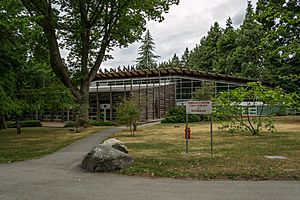Xwi7xwa Library facts for kids
Quick facts for kids Xwi7xwa Library |
|
|---|---|
 |
|
| UBC Longhouse 02 | |
| Country | Canada |
| Type | Academic library, archives |
| Location | University of British Columbia, Greater Vancouver |
| Coordinates | 49°15′55″N 123°15′24″W / 49.2654°N 123.2566°W |
| Branch of | University of British Columbia Library |
The X̱wi7x̱wa Library (pronounced "hwee-hweeh-wa") is a special library at the University of British Columbia in Vancouver, Canada. It focuses on books and materials about Indigenous peoples. The library's name comes from the Squamish language, meaning "echo." It is known for its unique way of organizing information. This method helps show Indigenous ideas and cultures. The library has about 15,000 items. It works closely with the main UBC library.
How the X̱wi7x̱wa Library Started
The X̱wi7x̱wa Library began as a small collection. These books and materials were about Aboriginal topics. They were kept in a mobile home. This collection was part of UBC's NITEP program. NITEP helps train Indigenous teachers.
In 1993, the collection became the First Nations House of Learning Library. It was moved into a longhouse. A longhouse is a special building for Indigenous students and scholars. In 1995, the university decided to create a special job. This job was for a X̱wi7x̱wa librarian. Gene Joseph was the first person to hold this important role.
Starting in 2008, the library began making digital copies of its materials. This was done to share university resources. The goal was to reach Aboriginal people all over the world. By 2015, the library had more than 15,000 items. Most of these items were about Aboriginal cultures and topics.
Organizing Books the Indigenous Way
The X̱wi7x̱wa Library uses a special system. It is called First Nations House of Learning (FNHL) Subject Headings. This system helps organize books about First Nations. It fixes problems found in other library systems. For example, the Library of Congress Subject Headings often do not properly describe First Nations materials.
The FNHL system organizes First Nations by their location. It also uses their own names for themselves. This is different from listing them alphabetically by European names. This system is a special version of the Brian Deer Classification System. Librarian A. Brian Deer (who is Mohawk) created this system. It focuses on how things are connected. This reflects an Indigenous way of seeing the world.
In 2004, about 11,000 FNHL headings were lost. This happened because of a computer system change. Luckily, they were found and brought back in 2009.
The library also checks how suitable materials are. They look at if a book can be used to teach Indigenous children. This shows that cataloging is not always "objective." It recognizes that Indigenous peoples are often shown incorrectly. This happens in many mainstream European-Canadian and American cultures.

